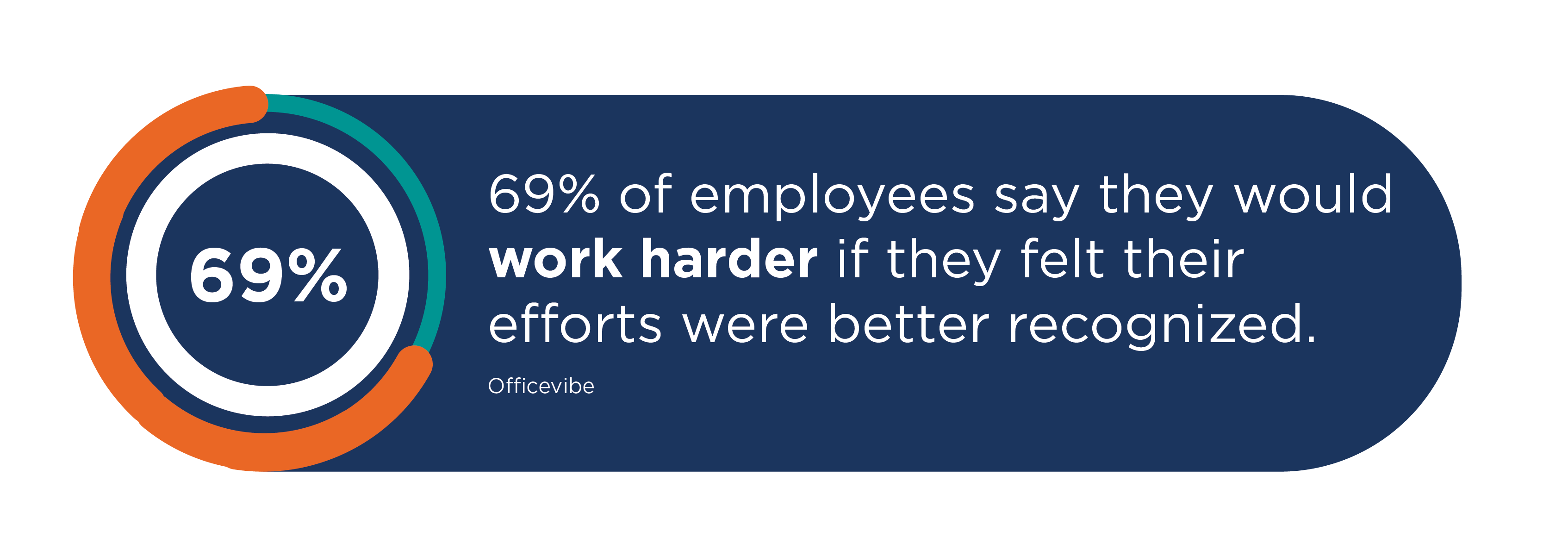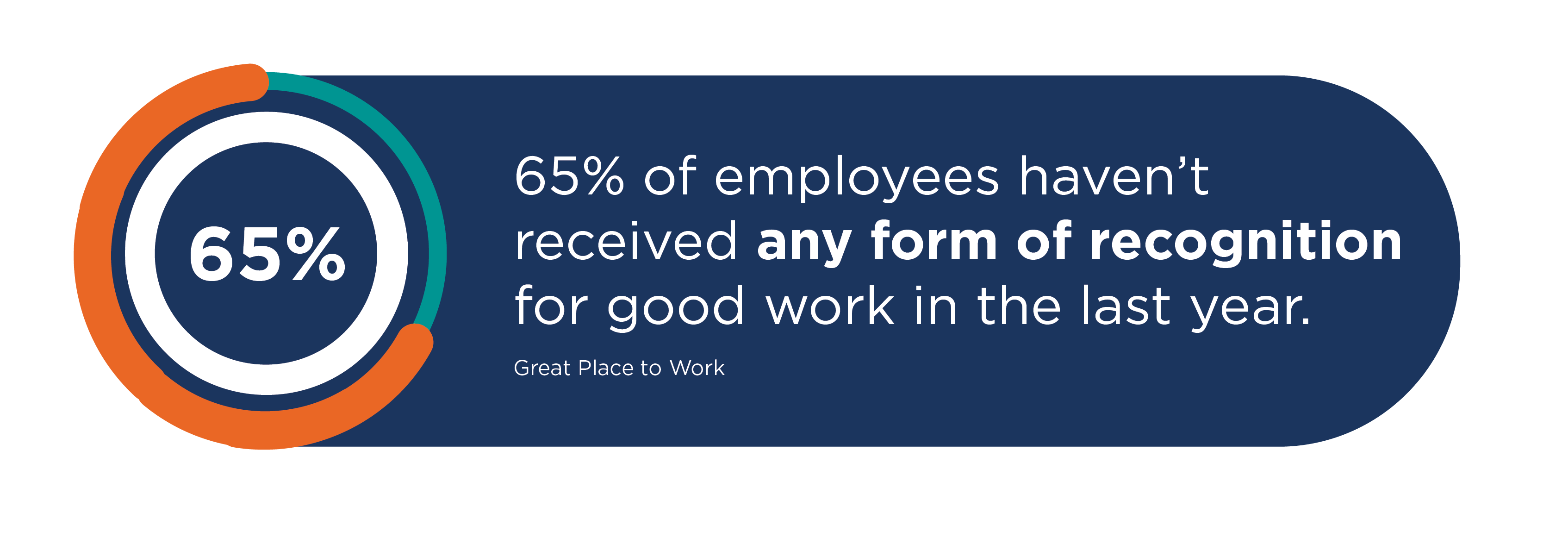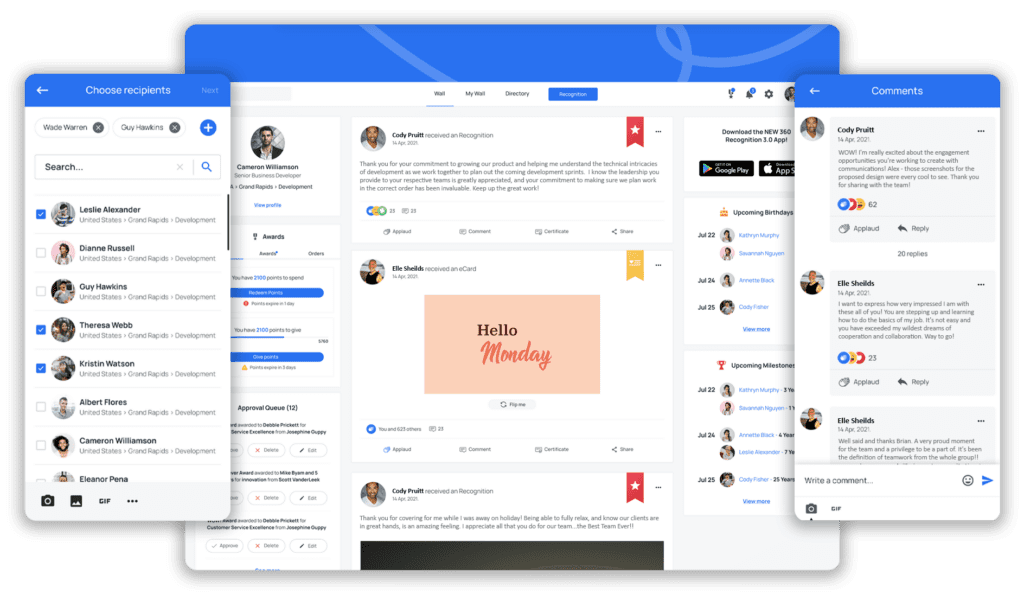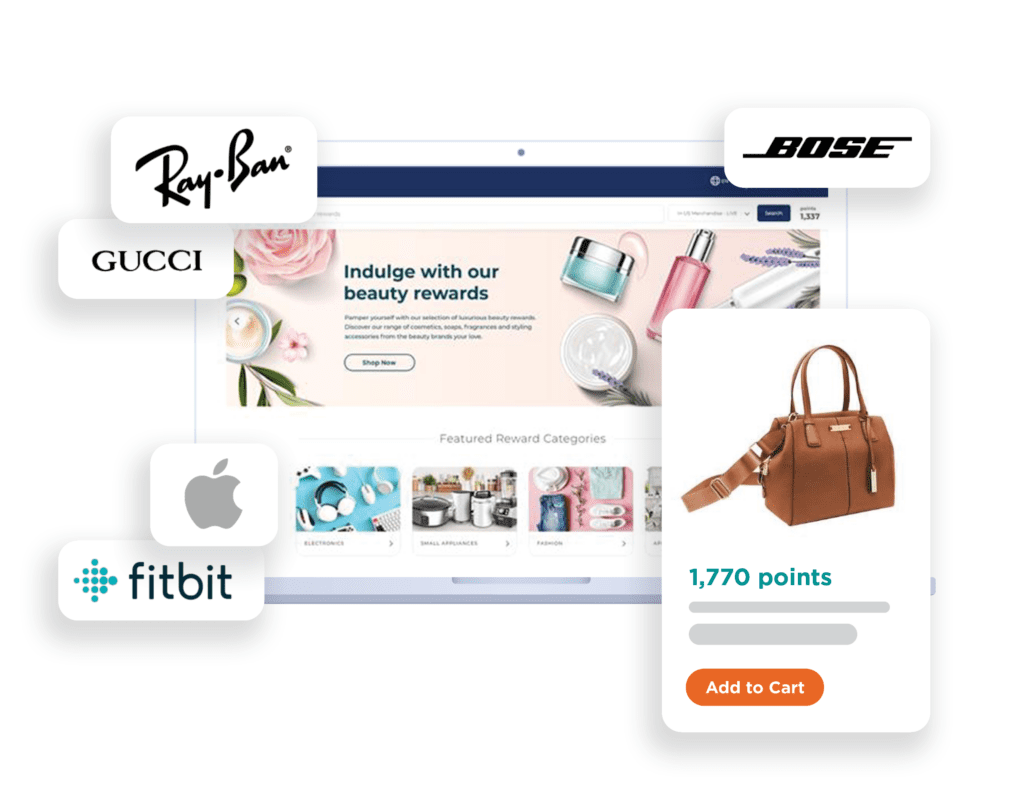February 19, 2025

Employee recognition may not be a new concept, but what is new is some of the latest employee recognition statistics that have come out of research surrounding employee engagement.
Meaningful recognition plays a crucial role in enhancing employee motivation, engagement, and overall job satisfaction.
From productivity to culture to retention - research shows recognition programs continue to be a key factor in improving a range of business outcomes.
But it’s one thing to believe in the effectiveness of employee recognition programs, it’s another to have objective data to support the cause.
Here we break down some of the key statistics on employee recognition that business leaders should consider in 2025.
Employee Recognition and Retention Statistics
Employee recognition research supports that employee recognition is directly related to employee retention. When employees receive recognition for their efforts and contributions, it enhances their sense of value and appreciation within the organization. However, a significant percentage of employees report never having received recognition, highlighting the gap in recognition practices and emphasizing the importance of timely and consistent acknowledgment.
This increased job satisfaction makes people more likely to remain with the company rather than seek opportunities elsewhere.
- The cost of replacing an employee can be up to 2x their annual salary, making retention a major financial priority. (Gallup)
- Organizations with strong employee recognition programs have 31% lower voluntary turnover than those without. (Bersin by Deloitte)
- Companies that implement regular employee recognition see a 14% increase in employee engagement and productivity. (Gallup)
- 79% of employees who quit their jobs cite “lack of appreciation” as their primary reason for leaving. (O.C. Tanner)
- 41% of companies that use peer-to-peer recognition see an increase in customer satisfaction. (SHRM)
- Employees who feel appreciated are 59% less likely to look for a new job due to burnout. (Gallup)
- 53% of employees say they would stay longer at their company if they received more recognition from their manager. (Workhuman)
- Employees who receive frequent recognition are 5x more likely to feel valued and motivated. (Gallup)
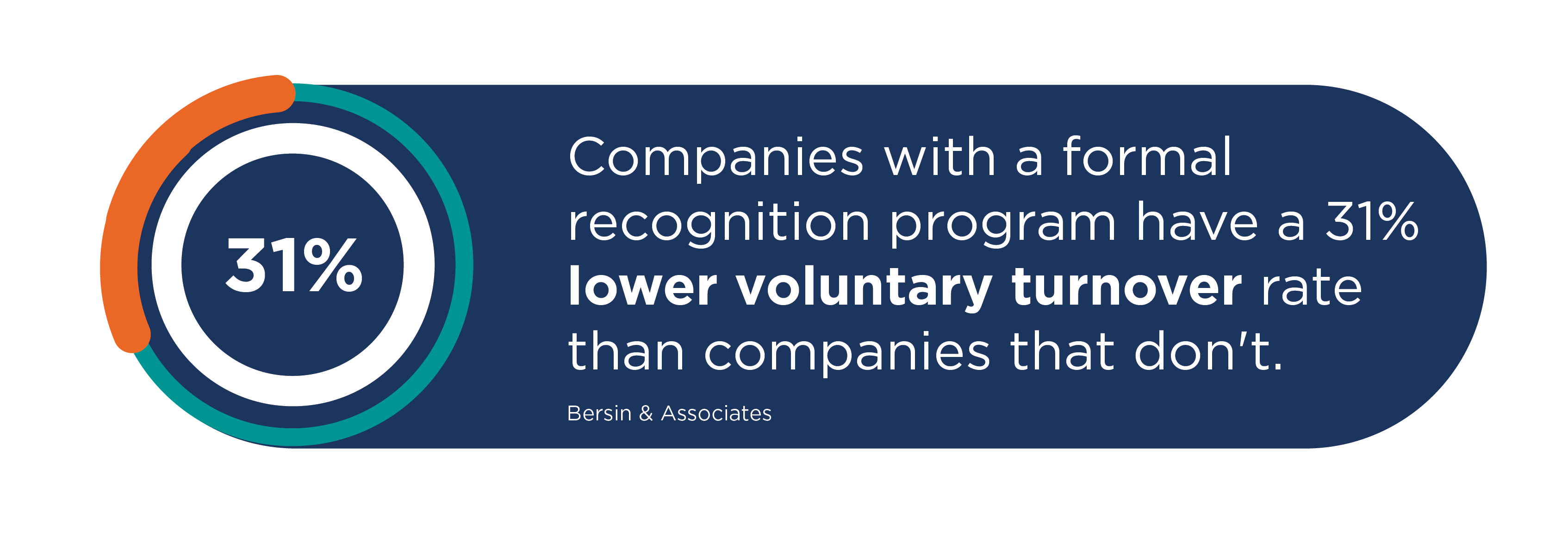
- Companies with strategic recognition programs are **48%**more likely to report high employee retention rates. (Globoforce)
- Highly engaged teams have a 40% lower turnover rate compared to disengaged employees and teams. (Gallup)
- Employees who do not feel adequately recognized are twice as likely to say they’ll quit within the next year. (Gallup)
- 66% of employees say they would leave their job if they didn’t feel appreciated. Employee recognition may also counter workplace stresses that could otherwise negatively impact employee performance.
- 47% of Human Resource professionals believed that employee turnover was the top workplace management challenge. (SHRM)
- Businesses lose roughly $1 trillion annually due to voluntary turnover. (Gallup)
- 82% of American professionals feel that they aren’t adequately recognized for their contribution. (OGO)
- Employees promoted after three years have a 70% likelihood of staying with your company. (LinkedIn)
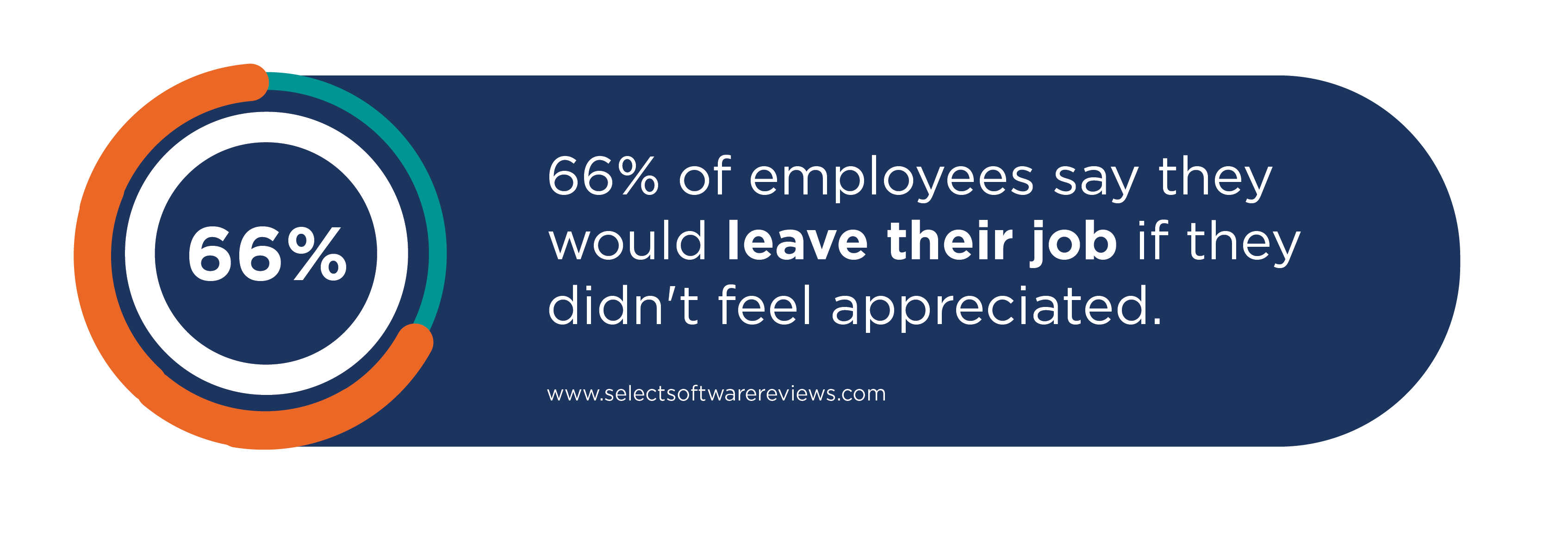
Bottom line: Poor retention is costly for companies in many ways. However, an effective employee recognition program can have a significant positive impact on retention.
Employee Recognition Statistics about Productivity
Recognition plays a crucial role in enhancing employee motivation, engagement, morale, and retention, all of which are closely linked to productivity.
It is essential to prioritize employee recognition as a key factor for minimizing turnover and achieving strong business outcomes.
By implementing effective recognition programs and consistently acknowledging and rewarding employees’ efforts and achievements, organizations can create a positive and productive work environment conducive to success.
- Employees who feel recognized at work are 2.5 times more likely to be happy with their jobs and 1.5 times more likely to feel motivated to do their best.
- Employees who are content with their work are 13% more productive compared to those who are dissatisfied. (Oxford University’s Saïd Business School)
- Employees who receive regular recognition are 23.3% more likely to be engaged at work, leading to increased productivity. (Gallup)
- 69% of employees say they would work harder if they felt their efforts were better recognized. (Officevibe)
- Highly engaged business units achieve a 20% increase in sales. (Gallup)
- Employees who feel recognized are 14% more productive than those who don’t. (Gallup)

- Highly engaged employees, often a result of recognition, show 21% greater profitability and 17% higher productivity. (Gallup)
- Employees who receive frequent recognition are 5x more likely to feel valued and motivated, leading to higher productivity. (Gallup)
- Companies with recognition programs experience a 22% increase in goal achievement and performance. (Deloitte)
- Teams that feel appreciated work 48% more effectively and are more likely to collaborate. (Workhuman)
- Employees who feel appreciated are 2.7x more likely to be highly productive at work. (Workhuman)
- Companies with strong recognition programs report a 33% increase in innovative thinking and problem-solving among employees. (Bersin by Deloitte)
Employee Recognition and Engagement Statistics
Sure, employee engagement is nice, but does it really matter? The answer is, absolutely. Companies with higher employee engagement are more resilient and better equipped to endure economic challenges.
Furthermore, higher employee engagement is also linked to increased customer satisfaction. Meaning, engaged employees are truly invaluable to the success of your company.
Just take a look at these employee recognition statistics about engagement.
- Employees who receive frequent recognition are 4x more engaged than those who don’t. (Gallup)
- Companies with peer-to-peer recognition programs see 26% higher employee engagement than those without. (SHRM)
- 85% of employees prefer public recognition, which boosts morale and engagement. (Workhuman)
- Employees who receive recognition at least once a week are 5x more likely to be highly engaged. (Gallup)
- Highly engaged business units achieve a 10% increase in customer ratings. (Gallup)
- 36% of US employees are engaged in their work, while 15% are actively disengaged. (Gallup)
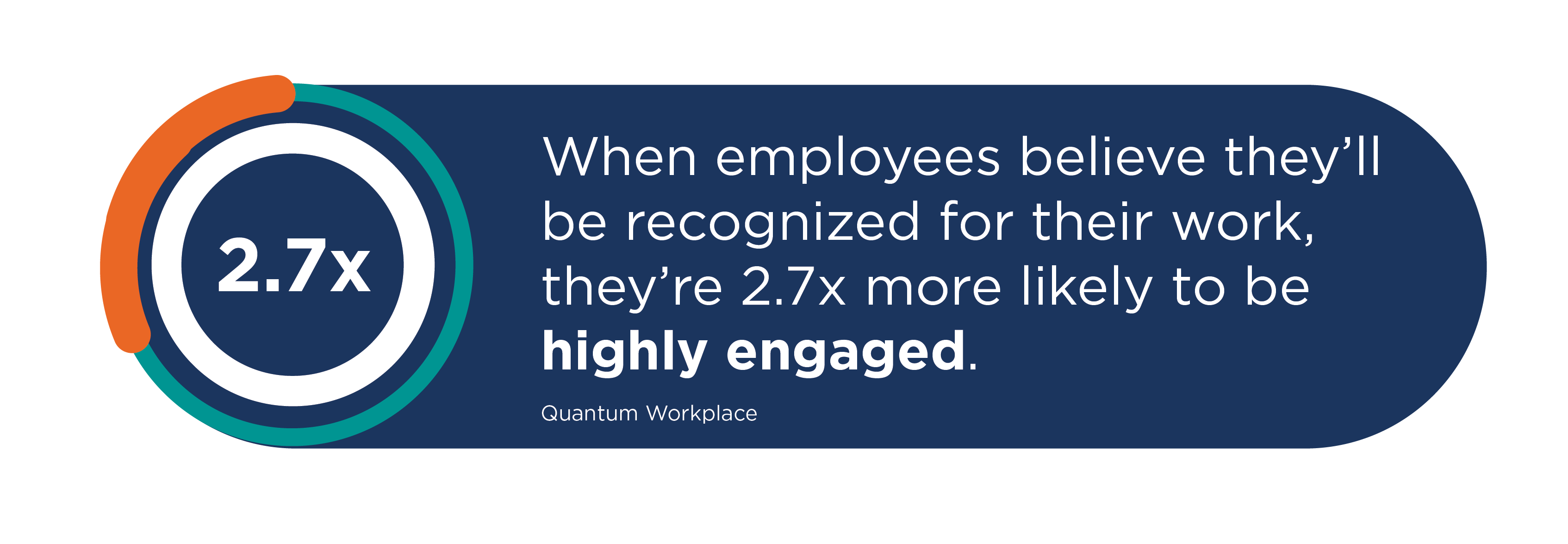
- When employees believe they’ll be recognized for their work, they’re 2.7 times more likely to be highly engaged. (Quantum Workplace)
- Employee engagement, productivity, and customer service are about 14% higher where recognition occurs compared to where it doesn’t.
- 72% of businesses agree that recognition impacts engagement positively. (Harvard Business Review)
- 82% of people are happier when they’re recognized at work. (Curiosity at Work)
- 81% of hybrid employees are highly engaged, followed by 78% of remote employees and 72% of on-site employees. (Quantum Workplace)
- The single most important driver for employees to do “great work” is employee recognition. (Great Place to Work)
Bottom line: Engaged employees are more likely to stay with their current company, be happier, and do better work. One way to increase employee satisfaction and engagement is to improve employee recognition.
General Employee Recognition Statistics
Other important employee recognition stats include:
- 92% of workers are more likely to repeat a specific action after receiving recognition for it.
- Verbal recognition from a manager in front of peers is preferred by 37% of employees. (Officevibe)
- 41% of companies that use peer-to-peer recognition have seen positive increases in customer satisfaction. (Globoforce)
- Peer-to-peer recognition has a direct link to higher engagement levels. (Gallup)
- Replacing an employee can cost the company one-half to two-thirds of the employee’s salary. (Gallup)

- 65% of employees haven’t received any form of recognition for good work in the last year. (Great Place to Work)
- 87% of company recognition programs emphasize tenure. (Forbes)
- Recognizing employees at least once per week is best for employee recognition. (Gallup)
- 85% of HR professionals say employee recognition programs positively affect organizational culture. (Mercer)
Employee Recognition Programs and Software
Employee recognition programs and software are essential tools for modern organizations, designed to streamline and simplify the recognition process. These programs offer a range of features, including customizable recognition schemes, rewards, and analytics. By leveraging employee recognition software, companies can enhance engagement and motivation, reduce bias and favoritism, and ensure a consistent and fair approach to recognizing employees.
These programs can be tailored to align with an organization’s unique culture, values, and goals, making them a versatile solution for fostering a positive work environment. Ultimately, recognition programs and software help organizations create a culture of appreciation, driving employee satisfaction and performance.
The Future of Employee Recognition
The future of employee recognition is poised to be shaped by technological advancements and evolving workforce demographics. With the rise of artificial intelligence and machine learning, recognition programs are expected to become more personalized and automated, offering tailored recognition experiences for each employee. As company culture and employee experience gain prominence, recognition programs will increasingly focus on creating inclusive and positive work environments.
Additionally, the growing trend of remote work and flexible arrangements will necessitate the adaptation of recognition programs to effectively acknowledge and reward remote employees. Overall, the future of employee recognition will be influenced by a blend of technological innovation, demographic shifts, and cultural changes, ensuring that recognition remains a vital component of organizational success.
10 Tips for Creating a Successful Employee Recognition Program
Implementing employee recognition programs can serve as an effective strategy for enhancing employee productivity, retention, and morale.
To ensure the success of such initiatives, consider the following tips. For a more in-depth guide, check out our blog, How to Build an Effective Employee Recognition Program.
1. Define Objectives
Before beginning a recognition program, it's important to first determine the goals of your recognition strategy. These might include:
Boosting Morale: Recognizing employees for their contributions helps boost employee morale, and creates a positive work environment.
Increasing Engagement: Acknowledging employees' efforts fosters a sense of engagement and commitment to the organization.
Improving Retention: Recognizing and appreciating employees' contributions can increase their loyalty to the whole company culture and reduce turnover rates.
Enhancing Performance: Employee recognition can motivate employees to perform at their best and achieve higher levels of productivity.
Fostering a Culture of Appreciation: Establishing a culture of recognition where employees feel valued and appreciated for their work is a key objective of how employee recognition programs work.
2. Understand Employee Preferences
Conduct employee surveys or focus groups to understand what types of recognition are most meaningful to your employees. Some may prefer public recognition, while others might appreciate private praise or tangible rewards.
3. Align with Company Values
Ensure that your recognition program aligns with the organization's core values and culture. Recognition should reinforce behaviors and achievements that reflect these values.
4. Establish Clear Criteria
Define the criteria for recognition to ensure fairness and consistency. Make it clear what types of accomplishments or behaviors warrant recognition and who is eligible to give and receive recognition.
5. Offer a Variety of Recognition:
Provide different types of recognition to cater to diverse preferences, job performance and accomplishments. This could include:
Social Recognition:
Social recognition refers to giving and receiving recognition through an online platform that celebrates achievements, and positive behaviors within the organization. This typically includes peer-to-peer recognition, employee rewards as well as manager recognition.
Social recognition is ideal for providing either private or public recognition. It also provides a level of automation for busy managers - like push notifications to send weekly recognition so you're sure to never let employees go unappreciated.
Custom Awards:
Employee awards are formal recognitions or honors given to individuals or teams within an organization to acknowledge outstanding performance, achievements, contributions, or milestones. These include:
Trophies
Custom wood awards, glass and crystal awards, and even 3D-printed awards can mark a special achievement that leaves a lasting impression.
Certificates and Plaques
Certificates and custom plaques are a great option for commemorating smaller, yet still significant moments, like a first anniversary or completing a major project.
Emblems
Emblems, like pins, charms, and tie-tacs can serve as a reflection of your company's identity for employees, donors, or members. These options are a step up from a certificate or plaque but are still more affordable than custom jewelry.
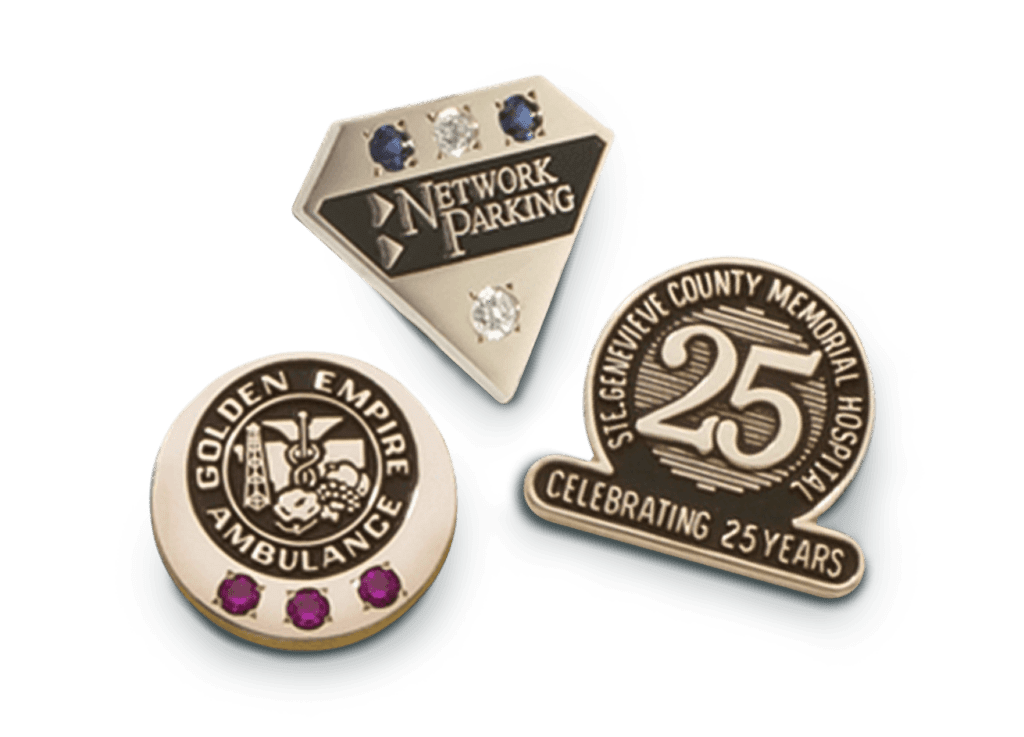
Jewelry
Custom recognition jewelry is a powerful symbol of recognition, accomplishment, and prestige. This option is typically given for momentous achievements and major milestones and includes the employer brand somewhere on the jewelry.

Milestones like Work Anniversaries and Service Awards
One of the most common and simplest forms of recognition employees get is work anniversaries or employee service awards. This option celebrates the time each employee has dedicated to your company.
While you don't need to go all out for every work anniversary, it's a good idea to acknowledge in some way each year an employee stays with your company. This not only helps make the employee feel appreciated, but it can also help with retention.
Points/Rewards:
Some companies show employee appreciation and recognition by using points to reward employees. These points can then be redeemed for merchandise, events, or experiences. This is oftentimes done through an online portal, like a social recognition site or redemption platform.
Terryberry's platform conveniently houses social recognition and a reward platform all on one platform. This allows employees to send and receive points and then shop for rewards seamlessly.
6. Make it Timely and Specific:
Employee recognition should be given in a timely manner. Recognizing someone in real time shows that you are paying attention to and acknowledging their efforts consistently.
Acknowledging achievements promptly also helps maximize the positive impact. Delayed recognition may diminish its effectiveness.
7. Involve Leaders and Managers:
Leaders and managers play a crucial role in reinforcing recognition. When senior leaders can actively participate in recognizing and appreciating employees, it sends a powerful message about the value placed on recognition within the organization.
Employees are more likely to follow suit when they see their leaders engaging in recognition efforts. Provide training and resources to help them effectively recognize and appreciate their team members.
8. Promote Transparency and Accessibility:
The success of an employee recognition program hinges on its ease of use. Programs should be accessible and straightforward to encourage ongoing participation.
It's essential to ensure inclusivity, catering to diverse workforces, including remote employees and individuals across all organizational levels, not just those working in-person at desks. Recognizing achievements across departments fosters unity and teamwork.
Utilizing an online social recognition platform can streamline the process and enhance convenience. Additionally, providing clear instructions on program operation and reward eligibility is crucial for employee engagement and understanding.
9. Collect Feedback and Iterate:
Consistent communication is vital for the success of any employee recognition program. Ensure employees are well-informed about the program's objectives and reward criteria. Keep channels open for feedback to understand their perspectives and suggestions.
Sending a regular employee recognition survey is effective for maintaining this dialogue. Utilize pulse surveys to gather insights from your employees, the primary users of the platform, fostering continuous communication and improvement.
Continuously gather feedback from employees and managers to evaluate the effectiveness of the recognition program. Use this feedback to identify areas for improvement and make necessary adjustments to keep the program relevant and impactful.
10. Measure Impact:
Measuring the impact of employee recognition programs is essential to understand their effectiveness and make data-driven decisions for improvement.
So, be sure to establish metrics to measure the impact of the recognition program on key outcomes such as employee engagement, retention, productivity, and morale.
Regularly analyze these metrics to assess the program's effectiveness and identify areas for improvement.
By following these steps and tailoring your approach to the specific needs and preferences of your organization, you can create an effective recognition program that fosters a company culture of appreciation, motivation, and engagement.
Getting Started
A recognition program can be a great way to improve employee productivity, retention, and morale. When done correctly, they can be an invaluable tool for businesses.
However, it is important to keep in mind that a good employee recognition program should have clear goals, be easy to use, and be consistent. Most importantly, they should be genuine and authentic.
Ready to get started with an employee wellness program or to begin an incentive program? Terryberry provides solutions to help drive performance and retention through effective employee engagement. These solutions include:
- Wellness Programs: We make it easy to run wellness programs and activity challenges that increase engagement, expand corporate health, and build team camaraderie.
- Pulse Survey Software: Be Heard is an employee engagement survey solution that's designed to enhance your employee experience while fueling business performance.
- Service Awards and Performance Awards: Recognize and reward employees based on years of service awards, anniversaries, or performance.
- Social Recognition: Empower your employees and managers to recognize their peers and celebrate successes with an easy-to-use social recognition application.
If you're thinking about implementing a strategy to recognize employees, schedule a demo with our team to see how Terryberry can transform employee engagement at your company.

